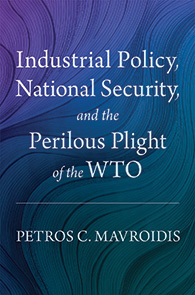A history of the WTO’s predecessor sheds light on contemporary trade tensions
INDUSTRIAL POLICY, NATIONAL SECURITY, AND THE PERILOUS PLIGHT OF THE WTO
Petros C. Mavroidis
Oxford University Press
New York, NY, 2025, 355 pp., $160
Industrial policy in the name of national security is surging, and it’s stretching the world trading system to the breaking point, according to Petros Mavroidis, a professor at Columbia Law School. His latest book, Industrial Policy, National Security, and the Perilous Plight of the WTO, should be required reading for trade experts and others trying to make sense of trade policy today. It tells the history of the current system, offers deep knowledge of World Trade Organization (WTO) legal structures and case law, and presents a sweeping account of how global trade and geopolitics interact.
Mavroidis, who worked in the WTO legal affairs division from 1992 to 1995 and has been a legal advisor to the organization since 1996, uses the example of semiconductors to illustrate the rise of global value chains and the growing entanglement of industrial and national security policies. The semiconductor industry, with its dual-use military and civilian technologies, has benefited from substantial government intervention. It’s where geopolitics and global value chains collide.
The book reminds us that many contemporary challenges are explained through the history of the 1947 General Agreement on Tariffs and Trade (GATT), which preceded the launch of the WTO in 1995. Weak subsidy rules and the international system’s inability to impose discipline are arguably at the core of some of the most contentious trade disputes today. The origins can be traced to the US view of the world at the time the agreement was drafted, Mavroidis argues.
US President Franklin Roosevelt, emboldened by New Deal policies and their accompanying subsidies, turned his attention to building a liberal international order that aimed to avoid “dissonance between domestic planning and international obligations.” Like the United States, the 22 other founding members of the tariffs and trade agreement were reluctant to limit their use of subsidies. They were market economies, but they relied on considerable state intervention to rebuild their societies after World War II.
The GATT’s framers failed to plan for a world that frequently invokes the national security exception. After all, the agreement was a “relational contract among like-minded players,” Mavroidis explains, and use of the provision was sparing. Since its beginning, of course, the agreement has evolved into the 166-member WTO, which represents over 98 percent of international trade and a spectrum of geopolitical and strategic interests. In recent years, use of this provision has become more common, and its use and abuse have led to “cosmic uncertainty” about the strength of the system.
The author argues, moreover, that the WTO was predicated on the misguided belief that we had already reached “the end of history,” that liberal democracy was inevitable, and that “China was on an irrevocable path toward becoming a market economy.” This had far-reaching implications for China’s WTO accession and amounted to missed opportunities to impose more controls on subsidies and state-owned enterprises.
The challenges confronting the multilateral trading system are immense, and Mavroidis does not purport to solve all problems. Instead he argues that the WTO is worth saving and proposes reforms to improve cooperation at least to “guarantee that there is a boat to navigate” when the environment is more conducive to change. This pragmatism is refreshing, but it is also a sobering reflection on where we are today.
Opinions expressed in articles and other materials are those of the authors; they do not necessarily reflect IMF policy.









